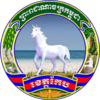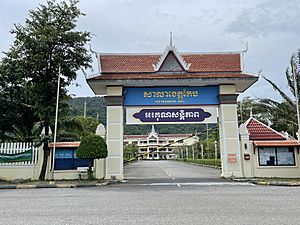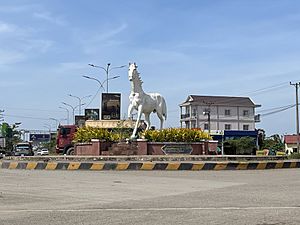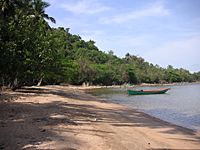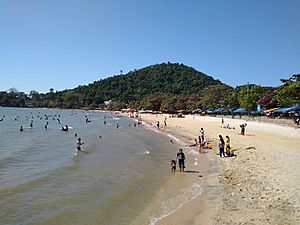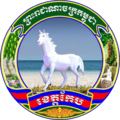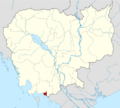Kep province facts for kids
Quick facts for kids
Kep
កែប
|
||
|---|---|---|
| Kep Province ខេត្តកែប |
||
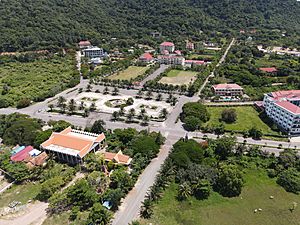
Kep Province Hall
|
||
|
||
| Nickname(s):
Côte de la perle d'Agathe (before khmer rouge)
|
||
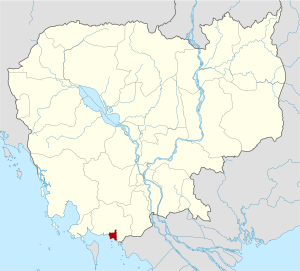
Map of Cambodia highlighting Kep
|
||
| Country | ||
| Provincial status | 22 December 2008 | |
| Capital | Kep | |
| Area | ||
| • Total | 336 km2 (130 sq mi) | |
| Area rank | 25th | |
| Population
(2023)
|
||
| • Total | ||
| • Rank | 25th | |
| • Density | 127/km2 (330/sq mi) | |
| • Density rank | 10th | |
| Time zone | UTC+7 (ICT) | |
| Dialing code | +855 | |
| ISO 3166 code | KH-23 | |
| Districts | 2 | |
| Website | https://kampot.city/kep | |
Kep (Khmer: ខេត្តកែប) is the smallest province in Cambodia. It covers about 336 square kilometers and has a population of around 46,888 people. Kep is one of Cambodia's newest provinces. It was created in 2008 from parts of Kampot province. The capital city is also called Kep. This province is home to the beautiful Kep National Park.
Contents
Geography
Where is Kep Located?
Kep province is almost completely surrounded by Kampot province. Its southern side has a 16-kilometer coastline along the Gulf of Thailand. This coast faces the Vietnamese island of Phú Quốc. Kep is about 20 kilometers from the town of Kampot to the west. It is also about 20 kilometers from the Vietnamese border to the east.
How Kep is Divided
Kep province is divided into two main parts: one district and one municipality. These are further split into five smaller areas called communes.
| ISO code | District | Khmer |
|---|---|---|
| 23-01 | Damnak Chang'aeur | ស្រុកដំណាក់ចង្អើរ |
| 23-02 | Kep Municipality | ក្រុងកែប |
- Damnak Chang'aeur: This is the largest part of the province. It has three main areas: Angkaol, Ou Krasar, and Pong Tuek.
- Kep Municipality: This area is in the center of the province. It is divided into two parts: Sangkat Kep and Sangkat Prey Thum.
Islands of Kep
The Kep Peninsula extends into the Kep Bay. Near the peninsula, there is a small group of 13 islands and islets. Here are some of them:
- Koh Tonsay (meaning 'Rabbit Island')
- Koh Kok (Egret Island)
- Koh Mtes (Chili Island)
- Koh Svay (Mango Island)
- Koh Tbal (Millstone Island)
- Koh Hal Trei (Dry Fish Island)
- Koh Svay Prey (Wild Mango Island)
- Koh Sarang (Sarang Island)
- Koh Pou (Enlightening Island)
- Koh Makprang (named after a wild fruit like a mango)
- Koh Angkrong (named after the Ziziphus cambodiana tree)
- Koh Ach Seh (Horse Dung Island, often called Kos Seh or Horse Island)
- Koh Snguot (Dry Island)
Koh Tonsay: Rabbit Island
Koh Tonsay is about 4.5 kilometers southwest of Kep. It is a popular spot for tourists. The island has two white sand beaches. The sea here is shallow, which is great for swimming. Under the water, you can find different corals, sea animals, and plants. These attract scientists and people who study nature.
The name Koh Tonsay comes from the word "Rumsay." Long ago, a prince named Sakor Reach led his tired troops across the sea to this island. His troops spread out to rest. Because of this, the island was called Koh Rumsay, which eventually became Koh Tonsay. Another story says locals used to call it Koh Antai.
Koh Tonsay is 2 square kilometers in size. In the past, simple paths and wooden motels were built on the island. Today, Koh Tonsay is a major tourist spot for Kep. There are about 8 basic guesthouses run by local people. You can also find about 5 restaurants, mostly serving fresh seafood like crabs and fish. Many day tourists visit, but it becomes quieter in the evenings. Electricity is usually available only from 6 PM to 9 PM from generators. During the dry season, water is brought to the island by boats with large tanks.
History
Kep's Resort Past
Under French rule, Kep was part of the Kampot area. It grew into Cambodia's most famous beach town. It was established in 1908 and called Kep-sur-Mer. Until the early 1970s, it was a busy resort for French and Cambodian important people.
Unique Architecture
Between 1953 and 1970, after the French left, Kep became known for its unique modern villas. Architects like Vann Molyvann created a style called New Khmer Architecture. This style mixed modern ideas from Europe with traditional Khmer building designs. King Sihanouk supported this new architectural movement.
Many people think that Kep's old French mansions were destroyed during the Khmer Rouge years. However, this is not entirely true. Local people, needing money and food, took apart the valuable parts of the villas. They traded these parts in Vietnam for rice and cash. Many of Kep's villas are now empty, but you can still see hints of the town's past beauty.
The coastline has wide sidewalks and large statues. Prince Norodom Sihanouk had his own villa and even his own island, Ile des Ambassadeurs. This was a favorite place for him to host guests.
Modern Kep
A paved road connects Kep with Kampot. Kep's coast mostly has mangrove trees and dark rocks. It doesn't have the white sands like Sihanoukville. However, white sand from Sihanoukville has been added to make Kep's beach wider and cleaner.
Today, Kep has more than 60 guesthouses, resorts, and hotels. It is becoming a popular tourist area in Cambodia. It focuses on mid-range to high-end places for visitors.
Education
Kep province has five secondary schools. In 2008, 588 students attended these schools. There were also 9 kindergartens and 21 primary schools. These schools taught a total of 9,644 students.
In the past, Kep had French schools, like the Sisters of the Providence's School. This school closed in 1975. Today, the Ecole pour Tous continues the French tradition of education. It mainly helps children in the area. Kep province does not have a university. Students who want to go to university usually go to nearby Kampot province.
The Don Bosco Technical School Kep teaches job skills to young people. The Kep Gardens Association also helps children and teenagers who need support.
The Kep International School (KIS) is the first English language school in Kep. It follows a Cambridge curriculum in the mornings. In the afternoons, it teaches Khmer subjects like reading, writing, and history.
Places to Visit
Rabbit Island (Koh Tunsay) is probably the most famous place to visit in Kep. But this small province has many other interesting spots. These places are promoted as ecotourism sites. This means they focus on protecting the environment. Both the local government and private groups like the Kep Tourist Association support this.
Kep Beach is located at the tip of the peninsula. This area has several old French mansions that are now in ruins. The beach used to have mostly black sand. Now, white sand from Sihanoukville has been added to make it nicer.
The Jungle Trek is inside the Kep National Park. It is an 8-kilometer path that goes around the hills of Kep.
The Butterfly Farm is a private garden focused on nature. It is in the Jasmine Valley Trail. This farm works to protect the local environment.
The Don Bosco Birth House Monument was opened in 2012. It is a copy of the house where John Bosco was born in Italy in 1816. It is located on the campus of the Don Bosco Vocational Center.
The Teuk Chhou Zoo is a private zoo. It is about 2.5 kilometers from the provincial town. The zoo is home to many different kinds of animals and plants.
Phnom Sar Sear has three small mountains. They cover about 1.5 square kilometers. The mountains are about 40 meters high and have several caves. The caves of Phnom Ach Pro Chiev and Phnom Dam Rey Sar are the most well-known.
Economy
Kep province's economy mainly relies on farming, fishing, tourism, and making salt. In 2008, 92% of the people in the province worked in agriculture. Most of them (75%) were rice farmers. In the same year, there were 10 registered guest houses. By 2013, there were 16 main hotels listed by the Department of Tourism. The Kep Expo is an event that helps promote Kep province as a place for tourism and development. It also highlights local artists and environmental protection.
Getting Around Kep
Highway No 33 goes through Kep province from west to east. It connects Kampot town to Kampong Trach District and then to the Vietnamese border. Another road, No 33A, branches off Highway No 33 at the Kep White Horse Monument. This road runs along the coast before rejoining Highway No 33 further east.
Kep does not have public bus or taxi services. Instead, people use motorcycle taxis, called moto-dop, and tuk-tuks. Bus companies like Phnom Penh Sorya Transport offer routes between Phnom Penh, Kep, and Kampot. You can also find shuttle bus services from Kep to Sihanoukville.
The province has a train station on the southern Cambodian Rail line. This line links Phnom Penh and the Port of Sihanoukville. However, as of 2013, the train line was not in use.
The small port in Kep is only used by small tourist boats. These boats sail to the Kep Archipelago, especially Rabbit Island. There are no regular boat services to other coastal towns in Cambodia or to neighboring countries like Vietnam and Thailand.
Images for kids
See also
 In Spanish: Provincia de Kep para niños
In Spanish: Provincia de Kep para niños


